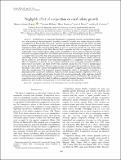Files in this item
Negligible effect of competition on coral colony growth
Item metadata
| dc.contributor.author | Alvarez-Noriega, Mariana | |
| dc.contributor.author | Baird, Andrew H. | |
| dc.contributor.author | Dornelas, Maria | |
| dc.contributor.author | Madin, Joshua S. | |
| dc.contributor.author | Connolly, Sean R. | |
| dc.date.accessioned | 2018-06-12T09:30:07Z | |
| dc.date.available | 2018-06-12T09:30:07Z | |
| dc.date.issued | 2018-06 | |
| dc.identifier | 253037152 | |
| dc.identifier | cd4744af-7bee-4a3b-a1ff-a8f023d69ffe | |
| dc.identifier | 85046543836 | |
| dc.identifier | 000434094400010 | |
| dc.identifier.citation | Alvarez-Noriega , M , Baird , A H , Dornelas , M , Madin , J S & Connolly , S R 2018 , ' Negligible effect of competition on coral colony growth ' , Ecology , vol. 99 , no. 6 , pp. 1347-1356 . https://doi.org/10.1002/ecy.2222 | en |
| dc.identifier.issn | 0012-9658 | |
| dc.identifier.uri | https://hdl.handle.net/10023/13932 | |
| dc.description | MD was supported by the ERC (BioTIME 250189) and the Scottish Funding Council (MASTS –HR09011). JM, AB and SC were supported by fellowships from the Australian Research Council (FT110100609, FT0990652 and DP0880544, respectively). | en |
| dc.description.abstract | Competition is an important determinant of assemblage structure and population regulation, often resulting in decreased growth, fecundity or survival. In corals, most studies testing for an effect of competition on demographic traits, such as growth, have been experimental and often impose very high levels of competition upon colonies. To more realistically assess the role of competition on coral traits, multispecies studies in the wild are required. Here, we use 5 yr of data that includes 11 coral species on the reef crest at Lizard Island on the Great Barrier Reef to quantify the effect of competition on growth. Additionally, we test whether species differ in their susceptibility to direct‐contact (overgrowth and digestion) and overtopping competition, and whether species from some morphological groups are more likely to compete with one another than with species from other morphological groups. We also investigate the relationships between competitive ability and three key traits: growth rate, mechanical stability and fecundity. In contrast to most previous work using field manipulations of competition, we found a negligible effect of competition on growth. Acropora species consistently won overtopping encounters but lost in direct‐contact encounters, and these results were consistent among the four Acropora morphological groups. In contrast, the massive Goniastrea spp. were poor at overtopping but generally won direct‐contact encounters. Only tabular colonies were disproportionally more likely to compete against one another than with other morphologies. This propensity increases intraspecific relative to interspecific competition, a phenomenon that can promote coexistence when it is present among dominant competitors. Good competitors grew more quickly and had higher fecundity but were less mechanically stable, implying a tradeoff between performance during disturbance vs. performance in the absence of disturbance. We conclude that competition among adults is less likely to influence community dynamics than previously thought. If competition does have an effect, it is more likely to occur at life‐stages other than adults. | |
| dc.format.extent | 10 | |
| dc.format.extent | 2124593 | |
| dc.language.iso | eng | |
| dc.relation.ispartof | Ecology | en |
| dc.subject | Aggregation | en |
| dc.subject | Competition | en |
| dc.subject | Coral | en |
| dc.subject | Demographic rates | en |
| dc.subject | Growth | en |
| dc.subject | Morphology | en |
| dc.subject | Tradeoff | en |
| dc.subject | QH301 Biology | en |
| dc.subject | NDAS | en |
| dc.subject.lcc | QH301 | en |
| dc.title | Negligible effect of competition on coral colony growth | en |
| dc.type | Journal article | en |
| dc.contributor.sponsor | European Research Council | en |
| dc.contributor.institution | University of St Andrews. School of Biology | en |
| dc.contributor.institution | University of St Andrews. Fish Behaviour and Biodiversity Research Group | en |
| dc.contributor.institution | University of St Andrews. Marine Alliance for Science & Technology Scotland | en |
| dc.contributor.institution | University of St Andrews. Centre for Biological Diversity | en |
| dc.identifier.doi | 10.1002/ecy.2222 | |
| dc.description.status | Peer reviewed | en |
| dc.identifier.grantnumber | 250189 | en |
This item appears in the following Collection(s)
Items in the St Andrews Research Repository are protected by copyright, with all rights reserved, unless otherwise indicated.

